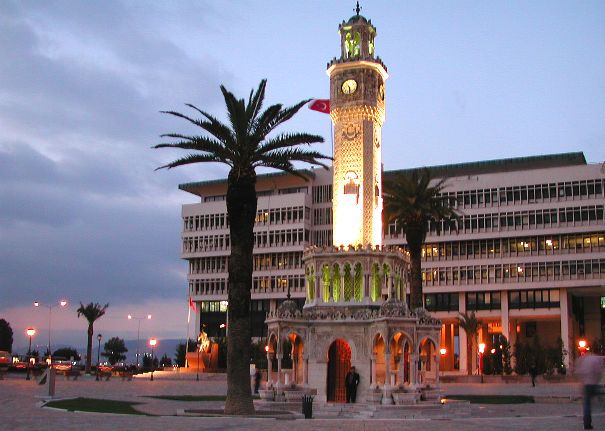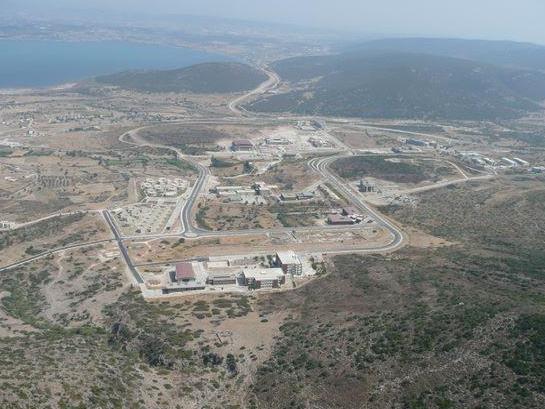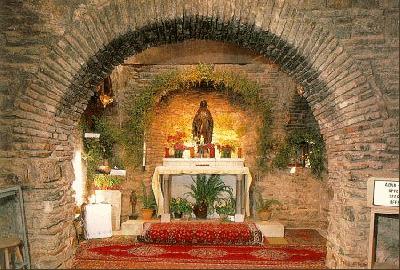Participants will be hosted in Izmir and they will have time for sightseeing in Izmir.
At the last day of the Symposium, there will be trip to Ephesus, Selçuk and Virgin Mary House.
Below, there is short information about Izmir, IYTE, Ephesus, Selçuk and Virgin Mary House.
Izmir:
To see the location of Izmir, please click here.

Turkey’s number three city after both Ankara and Istanbul, Izmir is home to one of the country’s leading ports and located within the Mediterranean basin. Izmir boasts an extraordinary history, spanning some 5,000 years, and has long been amongst the most cosmopolitan cities in Turkey, with many awesome archaeological sites relating to past Greek, Roman and Byzantine civilisations.
Surrounded by a series of scenic mountains, the Izmir of today in a modern and appealing tourist city, combining historical bazaars with more shops, such as those around Karsiyaka Pier and Konak Pier. The plentiful Turkish mosques add much character to the cityscape, while modern tourist information outlets are available on the central Gaziosmanpasa Bulvari and from a tourism booth conveniently sited next to the Clock Tower.
IYTE:

The İzmir Institute of Technology (İYTE) is a state university that places emphasis on research and graduate and undergraduate education in fields relevant to science and technology and on interdisciplinary studies. Like its international counterparts such as The Massachussetts Institute of Technology, the Institute adopts the organisational scheme of institutions of advanced education and intensive research oriented toward science and technology. It was founded by central government to be a centre of excellence in science and technology. In keeping with the Institute’s international identity and mission, the language of instruction is English.
The İzmir Institute of Technology is a state institution established in 1992 as the third university in the city of Izmir. Graduate education commenced in 1994. The first undergraduate students were admitted in fall 1998. In fall semester 2004, academic staff numbers 388, adiministrative staff 282. Current undergraduate matriculation is 1230, graduate students number 620. The Institute comprises a community of scientists, scholars and students, come together to explore, discover, create and produce at the vanguard of contemporary knowledge and industry. It is a centre of study and research serving the needs of human society. It welcomes and encourages the collaboration of all dedicated scientists and scholars who, through the process of research and reflection, contribute to these aims in an atmosphere of academic competence collegiality fostering scientific freedom and initiative. The founders’ vision includes the use, development, and production of advanced technology. In keeping with that vision, the Institute’s educational mission involves research in co-operation with the industry. It seeks the education of the entire scientist: profoundly aware of state-of-the-art research, engaged in actual technological production, and conscious of social responsibility. The campus technopark aims at establishing a firm link between education, training, and industrial research. A fundamental part of the founders’ vision, the technopark houses production units with research and development facilities. The focus at the Institute is on interdisciplinary education, offering major and minor programme options for competent students. In accordance with the Institute’s mission to explore and produce in an international framework, the language of instruction is English. Entering students with insufficient knowledge of English attend one year of Preparatory English School intended to lend fluency in professional and social life. Technical English and writing classes are available throughout the curricula for continued improvement and effective integration in the international academic community.
The campus of the İzmir Institute of Technology is located on one of the most beautiful stretches of Aegean coast just outside the city of Izmir. Comprised of 8650 acres (more than one third of the Grand Duchy of Luxembourg), it boasts an ancient Roman bath, its own waterfalls, olive groves, vineyards, valleys, hills, Mediterranean flora as well as landscaped areas—not to mention the breathtaking sunsets and dawns that must have inspired Anaxagoras as well as the builders of the earliest known olive oil atelier at Klazomenai some six kilometres from campus entrance. Unsurprisingly, the Institute’s geo-energy engineers discovered springs of thermal water on campus: the two peninsulae of Erythrai and Melenia at the junction of which campus lies, are well known for their contemporary thermal baths. Thus spanning an Edenic natural environment such as Antiquity knew it with expansive research and living premises and the urban facilities of an ancient, yet energetic, city of three million residents, the İzmir Institute of Technology offers a wide range of possibilities for the active, enquiring researcher as well as for the contemplative intellectual. Efficient transportation between campus and city centre is provided by the Institute via the Izmir-Çeşme motorway. Alternate transportation via scenic routes is also available. Situated on the sea and neighbouring upon fishing and resort villages, the campus carries the advantage of offering opportunity for various sea sports and other recreational activities. Campus mountains and hills are an attraction for trekkers and other outdoors sportsmen and women. As a result of ongoing forestry improvement work, the campus will possess a sizeable forest in the near future.
Ephesus

Ephesus was an ancient Roman and Greek city on the west coast of Anatolia, near present-day Selçuk, Izmir Province, Turkey. It was one of the twelve cities of the Ionian League during the Classical Greek period.
The city was famed for the Temple of Artemis (completed around 550 BCE), one of the Seven Wonders of the Ancient World. The Temple was destroyed in 401 CE by a mob led by St. John Chrysostom. Emperor Constantine I rebuilt much of the city and erected new public baths. The town was again partially destroyed by an earthquake in 614. The city’s importance as a commercial center declined as the harbor was slowly silted up by the Cayster River (Küçük Menderes).
Ephesus was one of the seven churches of Asia that are cited in the Book of Revelation.The Gospel of John may have been written here. It is also the site of a large gladiators’ graveyard.
Today’s archaeological site lies 3 kilometers southwest of the town of Selçuk, in the Selçuk district of İzmir Province, Turkey. The ruins of Ephesus are a favorite international and local tourist attraction, partly owing to their easy access from Adnan Menderes Airport and via the port of Kuşadası.
Selçuk

Selçuk is the central town of Selçuk district, İzmir Province in Turkey, 20 km (12 mi) northeast of Kuşadası, 5 km (3 mi) northeast of Ephesus. Its original name was Ayios Theologos, from which the Ottoman Turkish name Ayasluğ is derived. In 1914 it was renamed Selçuk, after the Seljuk Turks who settled in the region in the 12th century. It was a township in Kuşadası district till 1954 and Torbalı between 1954-1957. It finally became a district in 1957. Its neighbours are Torbalı from north, Tire from northeast, Germencik from east, Kuşadası from south, Aegean Sea from west and Menderes (formerly Cumaovası) from northwest.
Selçuk is one of the most visited touristic destinations within Turkey, known for its closeness to the ancient city of Ephesus, House of the Virgin Mary and Seljukian works of art. The 6th century basilica of St. John the Apostle, which, some claim, is built on the site of the Apostle’s tomb, is also inside the town. With the vast majority of tourists only using Selçuk as a stopping point for Ephesus and not visiting the town itself, the old quarter of Selçuk remains generally undisturbed and undeveloped, retaining traditional Turkish culture and locality.
Ayasoluk Hill dominates the surrounding area, with several historical buildings on its slopes, including the İsa Bey Mosque built by the Seljuk Turks in 1375, and the Grand Fortress.
The Ephesus Airport and Selçuk Training Center of the Turkish Aeronautical Association is only 3 kilometers away from Selçuk, offering piloting, parachuting, and microlight training.
The annual camel wrestling championship takes place in Selçuk in the Winter, near Ephesus.
